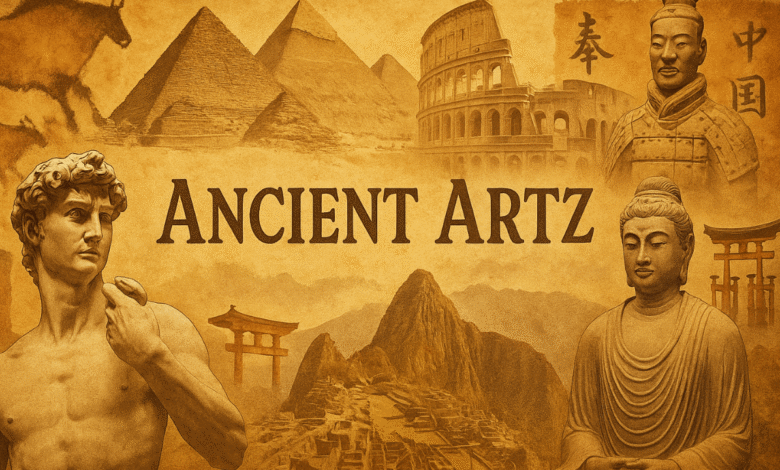Ancient Artz: A Timeless Journey into Human Creativity

From the earliest cave paintings to the majestic sculptures of ancient times, the story of human creativity is written in every brushstroke and chisel mark. Ancient art is not merely a reflection of the past; it is a living testament to how our ancestors expressed their beliefs, emotions, and understanding of the world. This article explores the fascinating evolution of ancient artz across cultures and epochs, highlighting its enduring influence on modern art and society.
The Origins of Ancient Artz in Prehistoric Times
The roots of ancient artz can be traced back to prehistoric eras when humans first began to record their experiences visually. Cave paintings in Lascaux, France, and Altamira, Spain, depict scenes of hunting and daily life. These early masterpieces were not mere decorations but served as spiritual symbols and storytelling devices. The use of natural pigments and simple tools reveals how early humans tapped into their environment to create meaningful expressions of their existence.
Ancient Artz in Ancient Egypt
One of the most iconic expressions of ancient artz flourished along the Nile River. Ancient Egyptian art is instantly recognisable for its distinctive style, symbolic colours, and profound religious themes. From the magnificent pyramids adorned with intricate carvings to the delicate paintings in tombs, every element of Egyptian art was designed to honour the gods and ensure a successful journey to the afterlife—hieroglyphic inscriptions combined language and art, creating one of history’s most fascinating visual records.
Ancient Artz of Mesopotamia
The cradle of civilisation, Mesopotamia, contributed significantly to the evolution of ancient artz. The Sumerians, Babylonians, and Assyrians developed a rich artistic heritage reflected in their monumental ziggurats, cylinder seals, and detailed relief sculptures. These works of art often depicted gods, kings, and mythical creatures, serving both decorative and political purposes. The famous Code of Hammurabi stele, with its carefully carved laws, remains a powerful example of art as a tool of governance and cultural identity.
Ancient Artz in Greece and Rome
Classical Greece and Rome elevated ancient artz to new heights of realism and idealism. Greek sculptors, such as Phidias, created lifelike statues that celebrated the human form and explored ideals of beauty and proportion. Roman art, while heavily influenced by Greece, introduced a flair for realism in portraits and intricate mosaics. Architecture flourished with the construction of the Parthenon, the Colosseum, and aqueducts—each a masterpiece of both engineering and aesthetic design.
The Influence of Ancient Artz in Asia
Asia’s contribution to ancient artz is both diverse and profound. In China, ancient artz can be seen in the delicate brushwork of early calligraphy, the intricate jade carvings, and the majestic Terracotta Army. India’s ancient artz includes the magnificent sculptures of Hindu temples and the serene Buddha statues of Gandhara. Japan’s early art, characterised by its elegant pottery and Shinto-inspired symbolism, reveals a profound connection to nature and spirituality. These works demonstrate the cultural richness and spiritual depth of Asia’s ancient civilisations.
Ancient Artz of the Americas
Across the Atlantic, the ancient arts of the Americas flourished in civilisations such as the Maya, Aztec, and Inca. From the impressive stone temples of Machu Picchu to the vibrant murals of Teotihuacán, these cultures utilised art to honour their gods, celebrate rulers, and mark significant astronomical events. Intricate textiles, pottery, and goldwork stand as a testament to their technical skill and creative spirit.
The Symbolism and Purpose of Ancient Artz
What unites all forms of ancient artz is the deep symbolism embedded within each creation. Whether through the depiction of deities, the celebration of natural forces, or the preservation of historical events, art served as a bridge between the material and the spiritual world. It provided a means of communication across generations and remains a valuable source of knowledge about ancient societies.
Ancient Artz and Modern Influence
The legacy of ancient artz continues to inspire contemporary artists, architects, and designers. Elements of classical Greek architecture can be seen in modern government buildings, while Egyptian motifs influence fashion and jewellery. Artists often revisit ancient styles to reinterpret them for contemporary audiences, demonstrating that the creative spirit of our ancestors remains resonant today.
Preserving Ancient Artz for Future Generations
Preservation of ancient artz is essential to protect our shared heritage. Museums, archaeological sites, and digital archives play a critical role in conserving these treasures. Advances in technology, such as 3D scanning and virtual reality, allow people worldwide to experience ancient artz without risking damage to original works. Continued research and conservation efforts ensure that these masterpieces remain accessible and inspiring for centuries to come.
Conclusion: The Eternal Legacy of Ancient Artz
Ancient artz stands as a timeless reminder of humanity’s boundless creativity and desire to communicate across time. From prehistoric caves to grand temples and intricate sculptures, these works connect us to our ancestors’ dreams, beliefs, and daily lives. By studying and preserving ancient artz, we not only honour the past but also gain insight into the universal human spirit. This enduring force continues to shape art and culture today.
You May Also Read: Mrs. Whittleburn: The Enduring Legacy of a Village Healer and Storyteller




